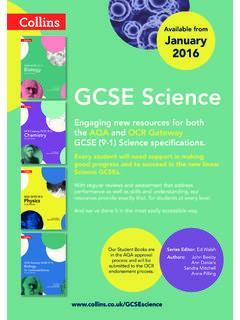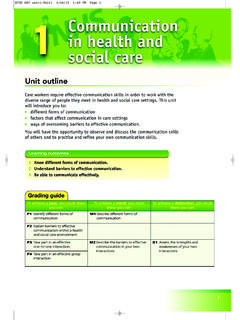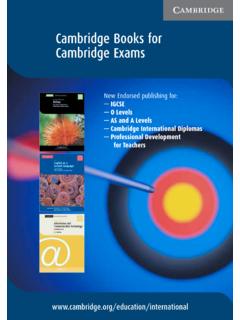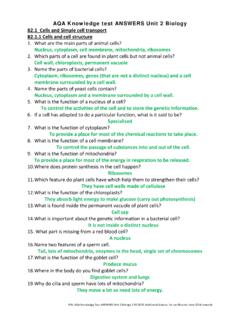Transcription of AQA GCSE (9-1) Biology - Collins Education
1 aqa gcse (9-1) BiologyTeacher PackAdvance draft material for the 2016 specificationsLouise SmilesSeries editor: Ed WalshDRAFTC ollins gcse Biology TP 110/12/2015 14:16 Chapter 1: Cell Biology Draft specification subject to Ofqual feedback and accreditation Collins gcse Science HarperCollinsPublishers Limited 2016 How the lesson plans work Every chapter and every lesson plan follows the same structure. Chapter introductions give an overview of the of the content and skills covered in the chapter help in assessing prior learning and identifying misconceptions list the overarching learning objectives to help medium-term planning.
2 Learning objectives and outcomes Learning objectives for each topic are listed and also shared with students in the Student Book for short-term planning. Learning outcomes at three levels are listed, and it is shown which learning activities contribute to achieving each outcome. Skills development show how the lesson will develop aspects of working scientifically. Resources needed and digital resources These give an overview of all the resources needed for a lesson. Every lesson has an associated differentiated worksheet to support written work.
3 Practical sheets are provided to give support for planning, carrying out and analysing practical work. Technician s notes are provided to explain the materials and setup and help with planning. These can be downloaded from the Collins website at Key vocabulary This is highlighted throughout to support literacy. Teaching sequence The lesson plans all use the same learning sequence. This is based on the idea that learning develops in stages during a lesson and that different parts of the lesson have different functions.
4 In addition to the learning cycles, the lesson plans all have three levels of differentiation: low, standard and high. Engage This section draws students in to thinking about the ideas, and includes possible starter activities. Here students encounter ideas that will make them want to find out more. Challenge and develop Students meet something that will challenge their existing understanding. It might be questions, ideas, demonstrations or experiments that make them realise the inadequacy of a simpler explanation.
5 Explain Students are encouraged to develop a good explanation and supported in capturing ideas in words or graphically. Differentiation ideas are given for students making less or more than expected progress. Consolidate and apply Students realise how the new learning is to be consolidated and applied, including real-world applications. Again, differentiation ideas are given for students making different levels of progress. Extend Addresses how the ideas of the topic can be extended to stretch students able to progress further.
6 Plenary suggestions Varied activities help in gauging student progress. Answers All answers to worksheet questions are provided. Chapter 1: Cell Biology Draft specification subject to Ofqual feedback and accreditation Collins gcse Science HarperCollinsPublishers Limited 2016 Cell Biology : Introduction When and how to use these pages This unit: builds on ideas that the cell is the building block of life. Cells can be specialised and be part of multicellular or unicellular organisms, like bacteria.
7 This chapter links to all chapters where the structure and functions of different systems are considered, for example, Photosynthesis and Health and where meiosis is explained. Overview of the unit In this unit, students will learn about the structure of plant, animal, prokaryotic and eukaryotic organisms, and the functions of major structures. They will compare the level of detail revealed by light and electron microscopes, calculating magnifications. Students will describe how cells divide by mitosis and applications of this in cloning techniques.
8 The use of stem cells in producing new tissues and organs will be evaluated in terms of ethical and moral considerations. Students will consider the differences between aerobic and anaerobic respiration, and learn about the uses of anaerobic respiration in baking and brewing. They will learn how to grow cultures of bacteria safely and investigate the effectiveness of different disinfectants on bacterial growth. This unit offers a number of opportunities for the students to use mathematics to carry out magnification calculations, plan and carry out investigations into the use of anaerobic respiration in baking, evaluate the effectiveness of disinfectants by preparing bacterial cultures and use graphical skills to analyse data in a number of different contexts.
9 Students will debate the use of embryonic stem cells in terms of moral and ethical considerations. Obstacles to learning The students may need extra guidance with the following terms and concepts: Cells and related topics are all abstract concepts and are hard to visualise. The use of cell models may help some students to make and see connections between different types of cells. Students often believe that cells are inactive, two dimensional structures and the use of videos and electron micrographs will enable them to see this is not the case.
10 Mitosis is also a difficult concept to follow, and the use of models will help students see the process more clearly and follow the stages more easily. Students often think that cells grow by simply becoming bigger, rather than by cell division. The idea that stem cells can become a nerve cell, or a muscle cell, can also be difficult for students to come to terms with. Students may believe that bacterial cells are the same as animal cells. Respiration is often confused with breathing, and needs to be linked to the mitochondria within cells so its roles within each cell can be emphasised.
















